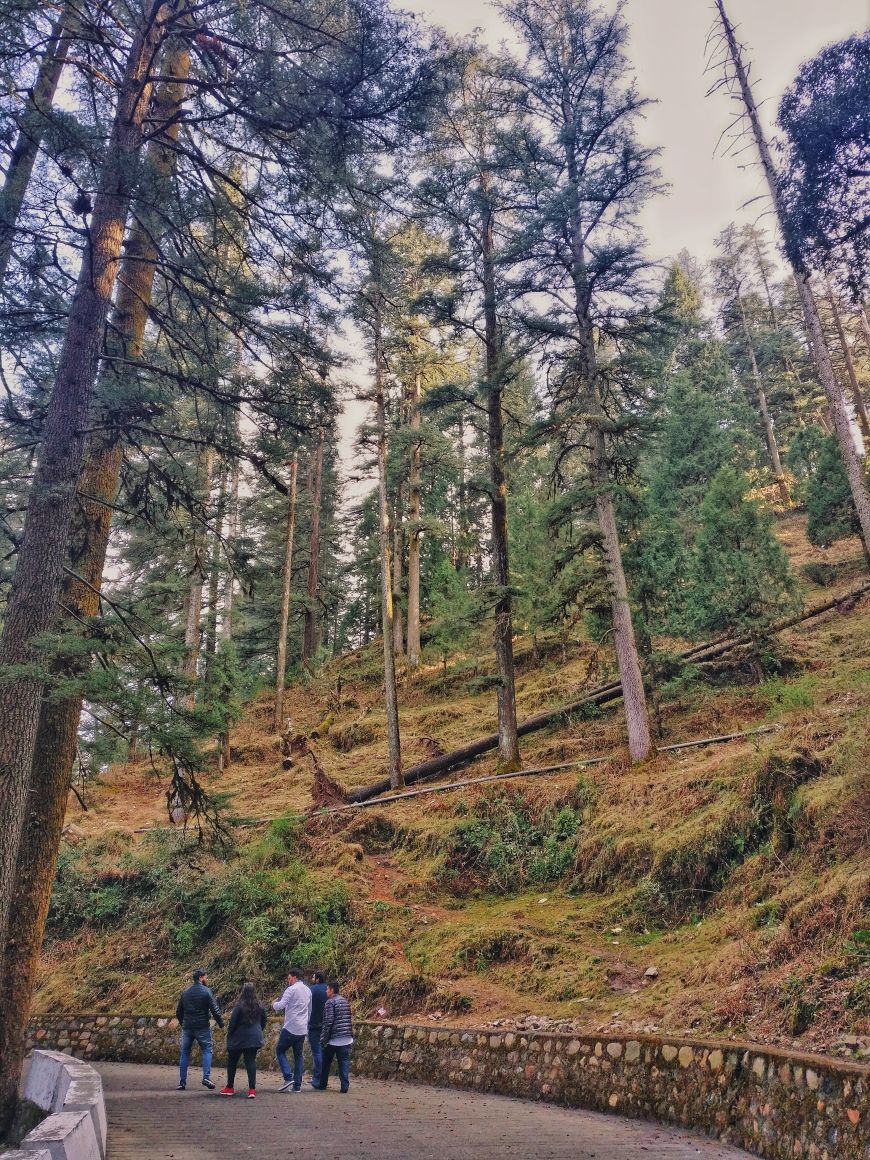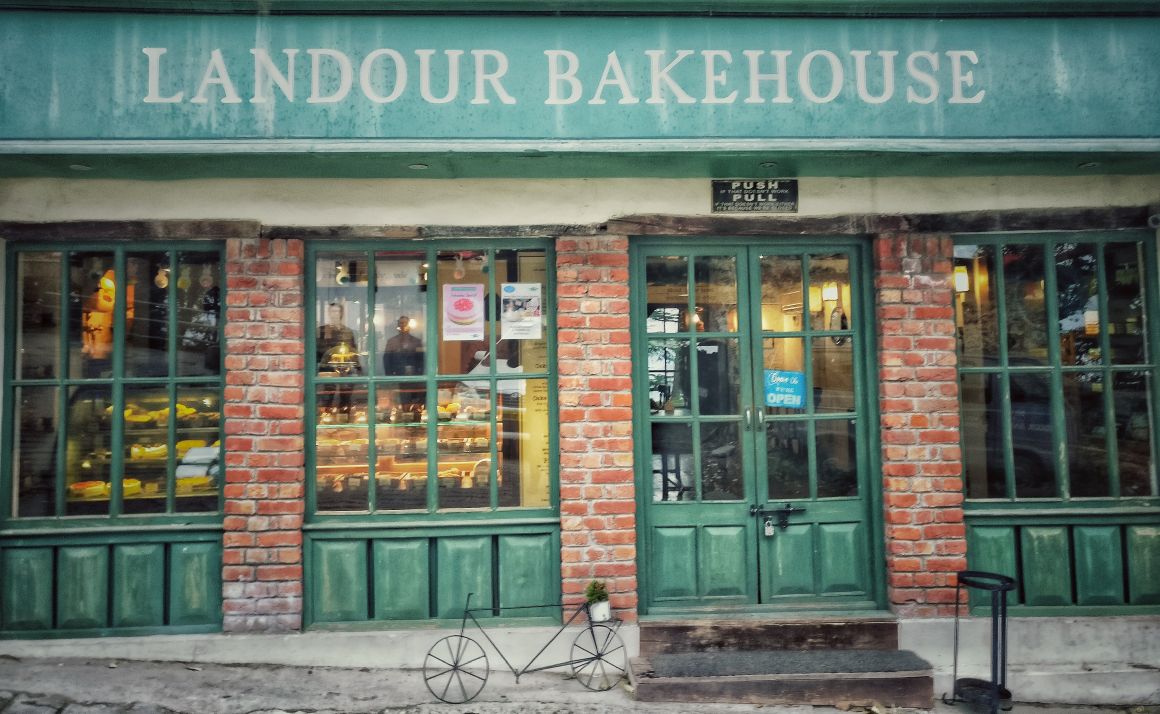Sunlight glinted on the hill-tops, and valleys were half dark and half lighted. Trees yawned as morning hue woke them from their slumber. The still breeze carried an indescribable purity and sweetness, laden with an aroma from the virgin forests. At a distance was this comfortable looking little town extending uphill and eastward. A steep four-five kilometers drive from Mussourie brought us to Landour, a British raj relic, a town, draped by an old fashioned aura, numerous colonial-era bungalows with slanting roofs, brick arches and stone walls, and silence that was interrupted only by the gusts of invigorating cold breezes. We glided over the shining track, going past the little houses with red thatched roofs and backyard, waving to the welcoming villagers who were off to collect the firewood, school kids and the typical heavily built, bush bearded, leather-jacketed Harley Davidson guys to reach the smiling Landour.

Life seemed to be taking a deep breath in the town; the natural beauty topped with reds and greens of roofs, extending a colonial reminiscence. We were passing through narrow roads that could barely fit two cars at a time. The driver was delicately maneuvering the car through these needle hole sized turns. Occasionally I had my head peering out of the car window to sap in the pure, cool breeze. There hung a certain, zeal in the breeze, flowing in gay abandon, like a harbinger of good times.
Taking another turn through Landour’s old bridle path, passing interesting sights and the famous St. Paul’s Church, with the endless stretches of pines and willows and the mountain sun filtering through the threshold of trees to accompany us; we reached one of the landmarks of the town, Rokeby Manor, our haunt for the next three days. And the property was everything that could have been expected; colonial touch taking you back to the era of 1840s when it was built, lovingly renovated rooms with stone walls and wooden floors, and cutely tucked gardens overlooking the valley.

The colonial charm of the 1840s at Rokeby Manor, Landour
Losing to the mystic of Landour
There was a certain feeling of escape in everything in Landour, an escape from everything that holds us in our lives. The desolate roads, the silence that wrapped the hills, the chill air that warmly embraces the town, and a feeling of being taken back to ages when remained an exclusively British preserve, with Indians kept off limits at Mussoorie, is magnetic. The picture perfect frames of pines and deodars strutted alongside the old bridle paths, is irreplaceable in the memory. Landour is a place to take long walks, detours, without any fear or regret of getting lost.
And the quaint Christmassy town of Landour, has a lot more to offer than just long walks. Eating your way in this small hilltown, makes you believe what a big heart it has. These are little hops, but enough for long-lasting impressions, and packed with unforgettable views. In landour, grab a bite at its iconic resident Mr Ruskin Bond’s next-door neighbour, Doma’s Inn. With its Tibetan food, kitschy Bollywood theme, scenic views, and unlimited friendly gestures, this place is a must stop. A 10 minute steep walk from there brings one to the buzzing Char-dukan area, where one should stop by for some tea and maggi break and catching on some small time gossip. Mind you this is the nucleus of all activities of Landour. A little ahead from there is the Lal-Tibba, named after the red mountains, offering an unbeatable combo of delicious food and breath-taking views of the valley. A little more walking and the bridled roads of Landour, taking you from one paradise to the other, you land up at the Landour Bakehouse, for some great bakery products, doles of cake, some gooey chocolate goodness, and a hot sipping coffee, doubled up with a great view to furnish a happy touch to your vacation. My suggestion, their crepes are a must try. And an artsy décor of the café, will lighten your spirits, and prepare you off for some more walks. A little uphill, is the Emily’s kitchen of the Rokeby Manor, some delicious continental choices, and a very quick service.

Some gooey goodness of chocolate and a hearty sip of coffee at Landour Bakehouse

Taken at Emily’s kitchen in Rokeby Manor
The landmarks of Landour
In the early 19th century, the Gorkha conquest of Kumaon–Garhwal, led to British shifting their military sanatorium from the plains of Dehradun to the silent hills of Landour, the cool area was just right for the homesick English soldiers. Landour is steeped in history and some unforgettable colonial charm. And many of its areas, Kenilworth, Ivanhoe, Waverly and Woodstock, echo the unmissable English connection. Many of the cottages of Landour are built in the Tudor style, reminiscent of that old connection. The first home in Landour was built in 1825 by Captain Young, the ‘discoverer’ of Mussoorie and commandant of the first Gurkha battalion raised by the British after the Gurkha War. He named his house ‘Mulingar’ after an old Irish town. Soon after him, a convalescent depot of soldier’s came up and with it the nurses’ camp, popularly known as sister’s bazaar these days. The house was later transformed to a hotel and then leased to British to house an overflow of soldiers from the sanatorium.
Landour’s literary affair is not new. It’s one of the first literary guest was Emily Aden, sister of Governor-General Lord George Eden, who wrote extensively on British racist attitude towards Indians, and after who one of the favourite dining places of Landour, the Emily’s kitchen is named.

Dishing the goodness of the age-old recipes of Landour

Emily’s kitchen in Rokeby Manor is named after Emily Aden, probably Landour’s first literary affair
For years, Landour remained an exclusive British preserves and a haunt of the Indian elites and ruling classes. Many Maharajas from Kuchesar to Rajpipla, Alwar, Jind, Kapoorthala, and Baroda had their summer houses in the exteriors of the Mussourie iconic Mall road, some extending up to the upper stretches, some extending up to Landour. Even today, it retains that exclusionary trait. The deserted paths, remind you that the place was preserved or reserved for a certain class. And there lives many folk tales, some based on truth and some beliefs, which have inspired many stories. As you take the right turn from the Lal Tibba towards the British cemetery, such stories come alive, of lost loves, treachery, and undisclosed secrets. A loop trail off the Mall road on the Camel Back Road, lies another and more known British Cemetary, where lies British adventurer Frederick ‘Pahari’ Wilson, who made his fortune and even minted his gold coins, by illegally harvesting timber, floating them down on the Ganges, and selling it to the British to build railway coaches. His story is said to have inspired Rudyard Kipling’s The Man Who Would Be King.
A view from the top
Mussoorie was also home to Sir George Everest, Surveyor General of India between 1830–43. Sir Everest carried out the Trignometrical survey of India, covering a 2,400 km stretch from South India to the Himalayas, including the measurement of some of the highest peaks of the world. A legend, he got his rest house done, at a secluded edge of a cliff, some six kilometers beyond the Hathipaon area. The house now lies in ruins, but trek up to the house can amaze you with the stupendous views of the Doon valley.

Nothing without a good valley view from the Lal-Tibba
And the buttery souvenirs
And that’s Landour’s little treat – peanut butter. When the Americam missionaries came here in 1830s, they brought with them equipment to make peanut butter on a commercial scale, and thus Landour, got set off on a yummy-treaty ride. Many of these settlers sold off their equipment after independence and thus how, one of these peanut butter making machine ended up in the hands of Anil Prakash’s family. Prakash’s store is now, to be place, for homemade peanut butter, jams, cheese and preserves. Now Prakash also runs a 12-room Devdar Woods hotel, with lovely Himalayan views.
Also central to all travel stories set in landour, are moments spent at Char Dukaan. In a literal sense, everything has stayed static at this point, except that shops have now got broadband and some better signage. This is the place to take a break from everything, sip in the tea and the moments, and let the fickle mist and the undecided drizzle roll in and out. These are cozy moments, designed to be packed in a kerchief, and treasured down the memory lane.
Head in the clouds
On the path to Lal Tibba, a board pinned on a tree says “If we liked noise we wouldn’t live here, if you like noise you shouldn’t be here”. Landour is to live free, pop your head out of the clouds, play with the fickle clouds, picture in constellation of fairy nights of the Doon valley, see the sky bursting into colours, lively sunshines and drizzles, brooding clouds, heart stopping photographic moments, giggly school children, elderly English men chatting in their sing-song Hindi, slick and glossy roads gleaming under golden lamps, deodars and pines turning into ghostly, dark woods, lamps and benches, long walks, casual chats, quiet hotels and cozy cottages, and of pretty Shivaliks melding with the mighty Himalayas. Landour is for rediscovering, and to find the artist or a writer within you.






Beautiful blog with beautiful pictures and stories…
Thanks a lot Tushar